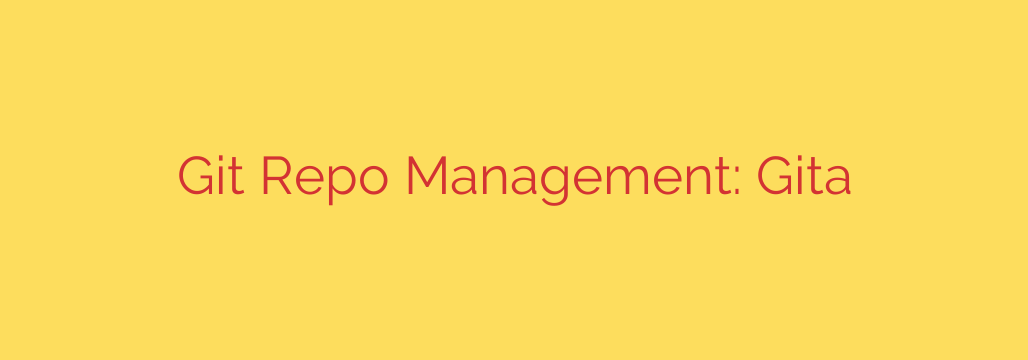
How to Effortlessly Manage Multiple Git Repositories
For developers, DevOps engineers, and anyone working in a modern tech environment, managing a single Git repository is second nature. But what happens when your projects scale? Suddenly, you’re not dealing with one repository, but five, ten, or even dozens. This is common in microservice architectures, multi-project client work, or when managing complex infrastructure configurations.
The daily grind of navigating into each directory (cd ../../project-b), checking the status (git status), pulling the latest changes (git pull), and repeating the process ad nauseam is a significant drain on productivity. It’s tedious, error-prone, and distracts you from the work that truly matters.
Fortunately, there’s a better way to handle this complexity. By using a specialized command-line tool, you can streamline your workflow and take back control of your repositories.
The Core Challenge: The Inefficiency of Repetitive Git Commands
Working with multiple repositories without a proper management system introduces several key problems:
- Lost Visibility: It’s easy to forget about uncommitted changes or branches that are behind their remote counterparts in a rarely touched repository.
- Repetitive Tasks: Running
git fetchorgit pullacross numerous repos one by one is a time-consuming and manual process. - Increased Risk of Errors: Manually performing operations increases the chance of forgetting a step, such as pushing changes in one repo that a dependent service needs.
- Constant Context Switching: Jumping between different terminal tabs and directories fragments your focus and disrupts deep work.
A Powerful Solution for Centralized Git Management
To solve these issues, you can leverage a powerful open-source command-line utility designed specifically to execute Git commands across multiple repositories at once. This approach allows you to view the status of all your projects from a single location and perform bulk actions with a single command.
One of the most effective tools for this is Gita, a lightweight yet robust Python-based utility that acts as a command-and-control center for all your Git-versioned projects.
Getting Started: A Quick Guide to Mastering Your Repos
Setting up a centralized management system is surprisingly straightforward. It typically involves a simple installation and a one-time configuration to tell the tool which repositories you want to manage.
1. Installation
First, you need to install the tool. If you have Python and pip installed, it’s as simple as running one command in your terminal:
pip3 install -U gita
2. Adding Your Repositories
Next, you need to add your existing repositories to the tool’s context. Navigate to the parent directory that contains all your project folders and use the add command:
gita add .
This command will scan the current directory for all Git repositories and add them to its configuration file. You can also add repositories from any location on your system by providing the full path.
3. Viewing All Repositories
Once your repos are added, you can get a bird’s-eye view of everything at once. The most useful command is gita ll or gita ls, which displays a clean, color-coded list of all your projects.
The output instantly shows you:
- The name of the repository.
- The current branch.
- The status of your working tree, such as uncommitted changes (dirty), untracked files, or if you are ahead or behind the remote branch.
This single command replaces the need to manually cd and git status in every single directory.
Core Commands to Supercharge Your Workflow
Beyond just viewing status, the real power comes from executing commands across your entire project landscape.
gita fetch: This is one of the safest and most useful bulk commands. It runsgit fetchon all your repositories, downloading the latest changes from their remotes without modifying your local files. This allows you to safely check for upstream changes across all projects without worrying about merge conflicts.gita pull: When you’re ready to update, this command runsgit pullon every repo, ensuring your local environment is fully synchronized with the latest remote versions.gita status: Whilegita llshows everything,gita statusis more focused. It only displays the status for repositories that are “dirty”—meaning they have uncommitted changes, are out of sync with their remote, or have untracked files. This helps you instantly identify where your attention is needed.gita push: Executesgit pushon all repositories that have local commits ready to be pushed to the remote.Run Custom Commands: Need to run a non-standard command? You can easily execute any Git command on a specific repository using the format:
gita <repo-name> <git-command>. For example,gita my-api-repo log --oneline -5.
Actionable Tips for a Secure and Efficient Workflow
While these tools are incredibly powerful, it’s important to use them responsibly.
Always Check Status First: Before running a potentially disruptive bulk command like
gita pull, always rungita statusorgita llfirst. This gives you a clear picture of your current state and helps prevent accidental overwrites or difficult merge conflicts.Be Cautious with Destructive Commands: Avoid running destructive commands like
git clean -fdxorgit reset --hardacross all repositories unless you are absolutely certain of the outcome. The power to do something everywhere comes with the responsibility to be careful.Integrate with Your Shell: For even faster access, consider creating shell aliases for your most-used commands, like
alias gll='gita ll'.
Conclusion: Reclaim Your Focus and Boost Productivity
Managing multiple Git repositories doesn’t have to be a bottleneck in your development process. By adopting a centralized command-line tool, you can move away from manual, repetitive tasks and embrace a more automated and efficient workflow.
This approach provides unmatched visibility into all your projects, reduces the mental overhead of context switching, and minimizes the risk of human error. By investing a few minutes to set up this system, you will save countless hours in the long run, allowing you to focus on what you do best: building great software.
Source: https://www.linuxlinks.com/gita-manage-multiple-git-repos/








